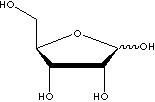PRODUCT IDENTIFICATION

200-059-4
H.S. CODE
TOXICITY
D-Ribo-2,3,4,5-tetrahydroxyvaleraldehyde; (2R,3R,4R)-2,3,4,5-tetrahydroxypentanal; Aldehydo-D-ribose; Aldehydo-D-ribo-pentose;
O1[C@@H]([C@H]([C@H](O)[C@@H]1O)O)CO
CLASSIFICATION
Aldopentose
EXTRA NOTES
A pentose active in biological systems usually in its D-form.
Other RN: 58-91-3, 6915-40-8, 93781-19-2
PHYSICAL AND CHEMICAL PROPERTIES
REFRACTIVE INDEX
Stable under ordinary conditions. Hygroscopic.
EXTERNAL LINKS & GENERAL DESCRIPTION
USA.gov - Ribose
Wikipedia Linking - Ribose
Google Scholar Search - Ribose
U.S. National Library of Medicine - Ribose
PubChem Compound Summary - Ribose
KEGG (Kyoto Encyclopedia of Genes and Genomes) - Ribose
http://www.ebi.ac.uk/chebi/ - Ribose
http://www.ncbi.nlm.nih.gov/ - Ribose
Material Safety Data Sheet - Ribose
EPA - Substance Registry Services - Ribose
Local:
Ribose
is a pentose (five-carbon sugar) that is a component
of the ribonucleic acid (RNA), where it alternates with
phosphate groups to form the 'back-bone' of the RNA
polymer and binds to nitrogenous bases. Ribose phosphates
are components of the nucleotide coenzymes and are utilized
by microorganisms in the synthesis of the amino acid
histidine. Its close relative, deoxyribose, is a constituent
of deoxyribonucleic acid (DNA), where it alternates
with phosphate groups to form the 'back-bone' of the
DNA polymer and binds to nitrogenous bases. The presence
of deoxyribose instead of ribose is one difference between
DNA and RNA. Ribose has one more oxygen atom in its
molecule than deoxyribose. Ribose has a five member
ring composed of four carbon atoms and one oxygen. Hydroxyl
groups are attached to three of the carbons. The other
carbon and a hydroxyl group are attached to one of the
carbon atoms adjacent to the oxygen. In deoxyribose,
the carbon furthest from the attached carbon is stripped
of the oxygen atom in what would be a hydroxyl group
in ribose. The sugar (ribose or deoxyribose) molecules
in the nucleic acid are all oriented in the same direction.
Their carbon atoms are numbered: the 5' carbon atom
is always on the side of the sugar molecule that faces
the leading end, while the 3' carbon atom always faces
the tail end. Nucleotide is the structural unit of a
nucleic acid. A nucleotide consists of either a nitrogenous
heterocyclic base (purine or pyrimidine) , a pentose
sugar (ribose or deoxyribose) and a phosphate group
attached at the 5' position on the sugar. A nucleoside
consists of only a pentose sugar linked to a purine
or pyrimidine base, without a phosphate group. Purine
bases are Adenine, Guanine and Hypoxanthine (examples
of purine nucleosides are Adenosine, 2'-Deoxyadenosine,
Guanosine, 2'-Deoxyguanosine, Inosine, 2'-Deoxyinosine).
Pyrimidine bases are Cytosine, Thymine, and Uracil (examples
of pyrimidine nucleosides are Cytidine, 2'-Deoxyguanosine,
5-Methyluridine, 2'-Deoxy-5-Methyluridine, Uridine,
2'-Deoxyuridine). The nucleoside derivatives are involved
in important functions in cellular metabolism and are
used to synthesize enzyme inhibitors, antiviral agents,
and anticancer agents.
APPEARANCE
98.0% min
OPTICAL ROTATION
-19º ~ -21º
88 - 92 C
HEAVY METALS
20ppm max
Hazard Symbols: , Risk Phrases: , Safety Phrases: 36/37